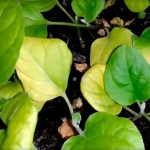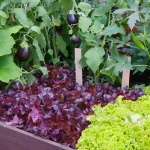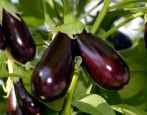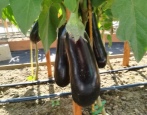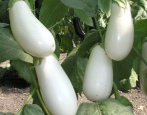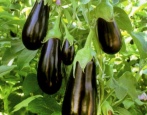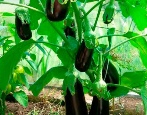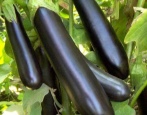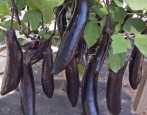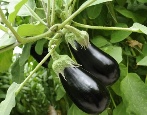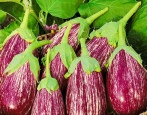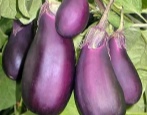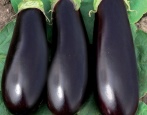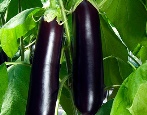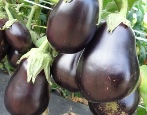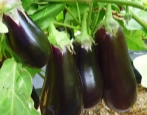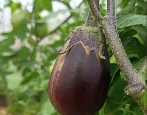
- Authors: Kachainik V.G., Gulkin M.N.
- Year of approval: 2018
- Bush height, cm: up to 100
- Fruit size: large
- Fruit shape: cylindrical
- Fruit weight, g: 200-300
- Yield: high yielding
- Ripening terms: early
- Pulp (consistency): dense, delicate
- Color of the pulp: white
The Black Giant eggplant was bred in 2018 by breeders V.G. Kachainik and M.N. Gulkin. But, despite such a young "age", he immediately won the hearts of gardeners with its excellent yield, large tasty fruits and resistance to various diseases.
Description of the variety
The Black Giant is a first generation high yielding hybrid. It bears fruit successfully both under a film cover, and in greenhouses, and in open ground. Possesses good immunity to viral diseases, resistant to temperature extremes. Recommended for cultivation in almost all regions of Russia, including the regions of Siberia and the Far East.
Characteristics of the appearance of plants and fruits
The Black Giant Eggplant is a tall plant that grows to a height of 100 cm and has a powerful root system. The bushes are closed, without spreading. The stem is slightly pubescent, with a weak anthocyanin coloration in its intensity. Leaves are medium in size, green in color, smooth with slightly wavy edges. There are no thorns on the calyx or they are very sparsely located.
The fruits of the Black Giant variety are very large in size. They are even, cylindrical in shape and weigh an average of 200-300 g. The fruits are characterized by a highly glossy shiny surface. At the stage of technical maturity, eggplants acquire a dark purple, almost black color.
Purpose and taste
This variety is characterized by fruits with dense, tender pulp, which is colored white. The taste of these eggplants is excellent. They are absolutely devoid of the bitter taste. The black giant is ideal for home cooking; it can be baked, stewed, stuffed, caviar and sautéed, grilled, and frozen.
Ripening terms
Early ripening is inherent in the Black Giant eggplant variety. The first fruits ripen 55-60 days after transplanting. Fruiting is intense, amicable, it lasts until autumn.
Yield
The black giant is known as a high-yielding hybrid. It is characterized by a high and continuous fruit set. When grown under film shelters, the yield is 9-10 kg / sq. m.
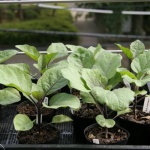
To get a tasty and bountiful eggplant crop, you must first grow strong and healthy seedlings. This culture is considered very capricious, therefore, you need to take care of seedlings when growing at home as correctly and carefully as possible.
Growing and care
The black giant is an easy-to-care variety that even novice gardeners can grow from seeds on their own. Sowing is recommended in late February - early March.
The earthen mixture should consist of equal parts of peat and humus, half of the total volume is covered with sawdust, and the soil is mixed. In the phase of one true leaf, the seedlings dive. Young plants of the Black Giant variety should be planted after 60-70 days.
In open ground, in a greenhouse or in a greenhouse, seedlings are planted in late May - early June. The site should warm up well and be illuminated by the sun's rays. It is recommended to adhere to the 60x40 cm planting pattern.
The Black Giant variety requires abundant and regular watering, systematic weeding and loosening. At the end of August, 5-6 of the largest ovaries are left on the plants, the rest should be removed.

Planting eggplant is one of the most important stages in growing. When choosing a place for eggplants on your site, it is important to remember that this culture should be in warm soil, constantly illuminated by the sun. The plant is also very fond of spacious, open spaces, since its roots can grow over sufficient areas.
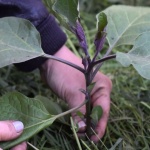

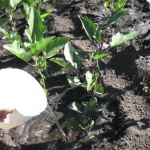
Soil requirements
Eggplants of this variety require slightly acidic loose warmed up soil. If the land on the site is sandy-clayey, you can add a bucket of sawdust, a bucket of manure and two buckets of peat to loosen it. Peat soil requires the addition of turf and humus.
If the soil is infertile, fertilizing is required every two weeks. The first feeding is done with a complex mineral fertilizer (20 g per bucket of water). Pour 500 g of such a mixture under each bush. It is recommended to apply organic fertilizers the second time. As a top dressing, 1 kg of mullein is most often taken, bred in a bucket of water and insisted for 7 days.

Eggplant is one of the most demanding crops. For its successful cultivation, it is necessary to create optimal conditions, as well as to carry out prevention and fight against diseases and pests. Eggplant often infects both fungal and viral diseases. If treatment is not started on time, you can completely lose the crop.



